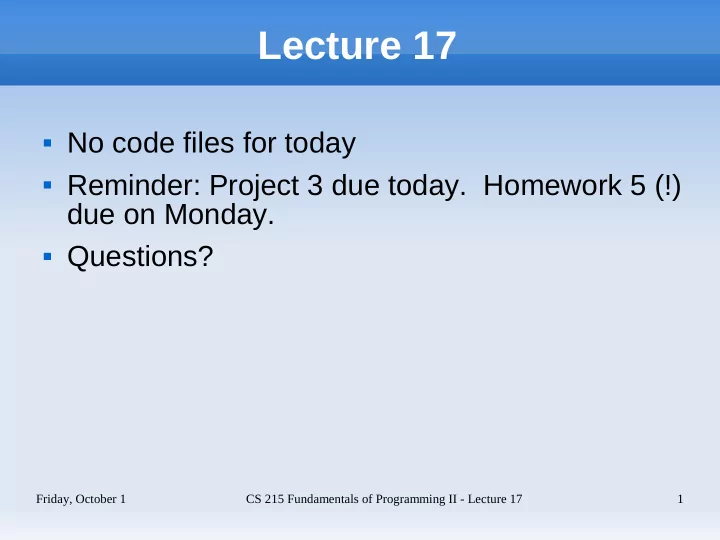

Lecture 17 No code files for today Reminder: Project 3 due today. Homework 5 (!) due on Monday. Questions? Friday, October 1 CS 215 Fundamentals of Programming II - Lecture 17 1
Outline Rules for dynamic classes Destructor, copy constructor, assignment operator Static multi-dimensional arrays Dynamic multi-dimensional arrays Friday, October 1 CS 215 Fundamentals of Programming II - Lecture 17 2
Destructor Prototype is ~ClassName(); Automatically called before an object is destroyed. Deallocates the dynamically-allocated data in the opposite order of construction. Friday, October 1 CS 215 Fundamentals of Programming II - Lecture 17 3
Copy Constructor Prototype is: ClassName(const ClassName & source); Automatically called to create a value parameter copy, a return value copy, or a variable with initialization. Dynamically-allocates a new data structure to hold a copy of the dynamic data of the source. Friday, October 1 CS 215 Fundamentals of Programming II - Lecture 17 4
Assignment Operator A member function. Prototype is void operator=(const ClassName & source); Called for assignments ClassName obj1, obj2; : obj1 = obj2; Must check for self-assignment. Deallocates the dynamically-allocated data in the opposite order of construction, then dynamically-allocates a new data structure to hold a copy of the dynamic data of the source. Friday, October 1 CS 215 Fundamentals of Programming II - Lecture 17 5
Rules for Dynamic Classes At least one attribute is a pointer variable. Member functions allocate and release memory as needed. The class will have custom destructor, copy constructor, and assignment (operator=) functions. Note: without a destructor, the class will create garbage, but will otherwise be correct. Without the copy constructor or the assignment operator, the class will be incorrect. Friday, October 1 CS 215 Fundamentals of Programming II - Lecture 17 6
Static Multi-dimensional Array int array2D[NUM_ROWS][NUM_COLS]; [0] [1] [2] [3] ...[NUM_COLS-1] [0] [1] [2] [3] : [NUM_ROWS-1] Access: array2D[i][j] Friday, October 1 CS 215 Fundamentals of Programming II - Lecture 17 7
Dynamic Multi-dimensional Array Cannot allocate a multi-dimensional array directly, since the new operator can create only a one-dimensional array. But we can think of a two-dimensional array as a one-dimensional array with one-dimensional array elements. Applying this idea to dynamically-allocated arrays, we get a pointer to an array of pointers to arrays of integer. Friday, October 1 CS 215 Fundamentals of Programming II - Lecture 17 8
Dynamic Multi-dimensional Array [0] [1] [2] [3] ...[NUM_COLS-1] array2DPtr ... [0] ... [1] ... [2] ... [3] : : ... [NUM_ROWS-1] Friday, October 1 CS 215 Fundamentals of Programming II - Lecture 17 9
Dynamic Multi-dimensional Array What is the type of array2DPtr? It is a pointer to an array of pointers to integer arrays. The type of the outer array elements is int * . So the type of a pointer to the outer array is int ** . How to allocate? Since dynamic, can ask the user for the dimensions, numRows and numCols . First allocate the outer array, then allocate the individual rows. Friday, October 1 CS 215 Fundamentals of Programming II - Lecture 17 10
Dynamic 2D Allocation To allocate the outer array say: int **array2DPtr = new int *[numRows]; type of the elements of the outer array To create each individual row, need to allocate an integer array and make an outer element point to it. for (int i = 0; i < numRows; i++) array2DPtr[i] = new int [numCols]; type of the elements in each row Friday, October 1 CS 215 Fundamentals of Programming II - Lecture 17 11
Dynamic 2D Access How to access an element of this data structure? Indexing is the same as with a static multi-dimensional array: array2DPtr[i][j] Why does this work? *(array2DPtr+i) => array2DPtr[i] => address of row array2DPtr[i]+j => address of an element *(array2DPtr[i]+j) => array2DPtr[i][j] Friday, October 1 CS 215 Fundamentals of Programming II - Lecture 17 12
Dynamic 2D Deallocation Deallocation needs to be done in the opposite order of allocation. Delete the rows first, then the outer array. // Delete the rows first for (int i = 0; i < numRows; i++) delete [] array2DPtr[i]; // Delete the outer array delete [] array2DPtr; Friday, October 1 CS 215 Fundamentals of Programming II - Lecture 17 13
In-class Exercise On a piece of paper, answer the following questions: 1. Write a declaration for a pointer variable array3DPtr that will point to a dynamic 3D boolean array. 2. Write the code for allocating storage for numRows x numCols x numDepth elements with array3DPtr pointing to the outer array. 3. Write the code to initialize the storage allocated in (2) to be true if the sum of the indexes of an element is even and false if the sum of the indexes of an element is odd. That is, element array3DPtr[i][j] is true if i+j is even, etc. 4. Write the code for deallocating the storage allocated in (2). Friday, October 1 CS 215 Fundamentals of Programming II - Lecture 17 14
Recommend
More recommend